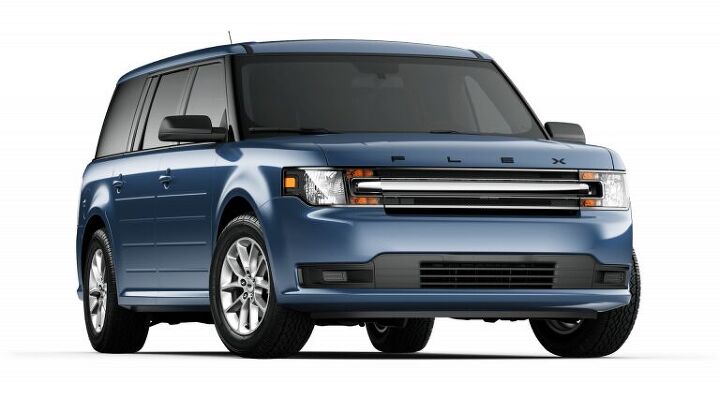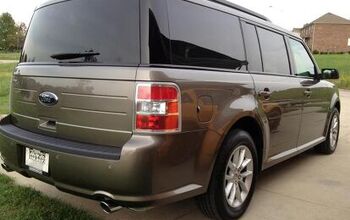Bark's Bites: A Moment of Appreciation for the Ford Flex

Seven years ago today, I bought a 2013 Mineral Gray Ford Flex SE. It wasn’t the ideal combination of options, nor was it the most desirable color — I would have preferred something in a Blue or Red, but Flex inventory was pretty limited, and Ford was offering some sort of quarterly promotion on in-stock inventory that was expiring that same day, so Mineral Gray SE it was.
180,000 miles later, it’s still in service as the family hauler. It’s taken thousand-mile-plus trips to places like Orlando, Minnesota, Kansas, and Iowa every summer, loaded to the gills with suitcases and sleeping bags. It’s endured through dozens of fruit punch spills and had hundreds of Cheerios trampled into its carpets. It even took a 40 mph hit to the rear subframe at a dead stop, and the precious occupants inside, my two young children, suffered nothing except a cup of spilled chocolate milk (which the interior also suffered, with a smell that took multiple cleanings to exorcise).
It started making a weird whirring sound in the dash a few years ago, but when the Ford tech said it would cost a few hundred bucks to fix, we simply got used to it. The “Check Fuel Filler Inlet” warning comes on every so often, as it does with all Fords of this era with capless fuel fillers, but I just clean it out and wait for the CEL to clear. It has consumed six sets of tires, but only two sets of brake pads — and it’s on the original shocks. I nearly knocked myself out with the tailgate once, thanks to the lack of a push-button feature, but honestly, I deserved it.
In other words, the Flex, long since paid off, continues to do exactly what I bought it to do all those years ago — transport my family with relative ease and comfort. I confess that I enjoy not having that $500-a-month payment anymore, and I fully expect to drive it another 2-3 years without issue (knock on wood). But if I did want to replace it, I’d have trouble doing so, because Ford won’t be making it after the 2019 model-year run expires. And that’s kind of a shame, because there’s nothing else like it.
Five years ago, I wrote this about my Flex:
I anticipate driving my Flex until it hits the 150K mark, myself, and its flawless mechanical performance over the first nearly 60K gives me no reason to think that it won’t easily hit that milestone and beyond. However, when it comes time to replace it, I hope that Ford is still making new examples. Unlike nearly every other car I’ve ever owned, I have no itch to replace it with anything other than another one just like it.
I still feel the same way today, but having eclipsed a mileage mark that’s 20 percent higher than I predicted, an odometer reading that is 75k miles higher than any car I’ve ever owned before, I realize that I was pretty conservative with that 150k prediction. I also realize that while I can still roll down to the local Ford dealer and buy a new 2019 Flex for even less actual money than I paid for mine, even adjusting for inflation, I would feel foolish for doing so, considering that my Flex is showing no signs of slowing down.
The market rarely gets these sorts of things wrong, of course. It’s all fine and good for enthusiasts to pine after the Honda S2000, for example, but by the time the legendary two-seater stopped shipping to dealers in 2009, Honda was only selling about two of them per day. But the Flex seems to be somewhat of an outlier.
After a bit of a spike in sales in 2013, the Flex has evened out to about 20k sales per year ever since. This year the Flex will probably sell in numbers slightly below that — around 17k. Considering that all of the tech and the platform in the Flex were developed about a decade ago, it would seem that Ford probably prints money with each Flex sold, regardless of volume. The Oakville plant, where the Flex and its Lincoln platform mate, the MKT, are made, has laid off about 200 workers this year due to slowing sales, but one wonders if the slowing sales is more a factor of planned obsolescence than diminished market demand.
I say this because the Flex holds its value like very few vehicles on the market. Even a 2013 Flex like mine, pushing 200k on the clock, will still bring $10k if it’s in good condition. Of course, Saab enthusiasts everywhere can tell you how it goes when you have a model that’s very desirable on the used market but not quite as desirable when sold new.
As I said earlier, there really isn’t anything else like it on the market. Every other seven-seater out there comes with elevated ride height standard, which I don’t want. While I know that most soccer moms out there like being higher, I appreciate the ease of entry and exit from the Flex in its very car-like stance, and my kids do, too. I find myself frustrated by the lack of accessible storage in other SUVs — having the Flex is like having one of those U-Haul trailers that advertises a lower deck. It’s just easier for loading everyday things like groceries and folding chairs for soccer games.
I imagine that I’ll find myself searching for a lightly-used 2017-2019 model by the time the Flex hits 220-250k miles — or maybe, after taking a few rides in big brother’s Lincoln MKT, I’ll be searching for one of those. He got his MKT for Flex SE pricing, thanks to the Lincoln depreciation penalty, and the MKT has more storage and better paint.
So I say to you, fellow Soccer Dads who don’t want a minivan but don’t love the idea of having the same Explorer/Highlander that everybody else at the soccer fields has, go check out a Flex. After seven years and the equivalent of more six trips around the equator, it’s the only car I’ve ever owned that I recommend without a single hesitation.
[Image: Mark “Bark M” Baruth, Ford]

More by Mark "Bark M." Baruth
Latest Car Reviews
Read moreLatest Product Reviews
Read moreRecent Comments
- ToolGuy First picture: I realize that opinions vary on the height of modern trucks, but that entry door on the building is 80 inches tall and hits just below the headlights. Does anyone really believe this is reasonable?Second picture: I do not believe that is a good parking spot to be able to access the bed storage. More specifically, how do you plan to unload topsoil with the truck parked like that? Maybe you kids are taller than me.
- ToolGuy The other day I attempted to check the engine oil in one of my old embarrassing vehicles and I guess the red shop towel I used wasn't genuine Snap-on (lots of counterfeits floating around) plus my driveway isn't completely level and long story short, the engine seized 3 minutes later.No more used cars for me, and nothing but dealer service from here on in (the journalists were right).
- Doughboy Wow, Merc knocks it out of the park with their naming convention… again. /s
- Doughboy I’ve seen car bras before, but never car beards. ZZ Top would be proud.
- Bkojote Allright, actual person who knows trucks here, the article gets it a bit wrong.First off, the Maverick is not at all comparable to a Tacoma just because they're both Hybrids. Or lemme be blunt, the butch-est non-hybrid Maverick Tremor is suitable for 2/10 difficulty trails, a Trailhunter is for about 5/10 or maybe 6/10, just about the upper end of any stock vehicle you're buying from the factory. Aside from a Sasquatch Bronco or Rubicon Jeep Wrangler you're looking at something you're towing back if you want more capability (or perhaps something you /wish/ you were towing back.)Now, where the real world difference should play out is on the trail, where a lot of low speed crawling usually saps efficiency, especially when loaded to the gills. Real world MPG from a 4Runner is about 12-13mpg, So if this loaded-with-overlander-catalog Trailhunter is still pulling in the 20's - or even 18-19, that's a massive improvement.



































Comments
Join the conversation
I could never imagine owning Flex or even worse MKT. At least Flex is like a bigger Scion. MKT is pure horror ugly. It means one has given up on life. I don't know if Flex is more reliable than Durango, but if a three row vehicle with some verve is your thing, I highly recommend a Durango with a HEMI. Mind you the pentastar is also a great engine, just not very fast (it sounds good though when you rev). In GT trim Durango really looks good.
I've always wanted to get a final year Flex to replace my Optima Turbo and problematic Roadmaster, and go back to having a single vehicle. Not quite ready to give up on the Buick yet, though another winter of it taking my garage spot might convince me to make the move in the spring.